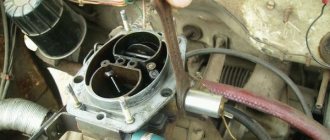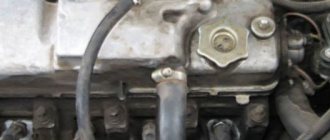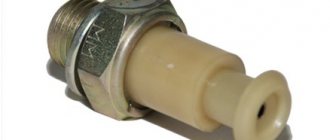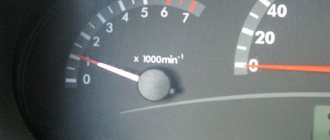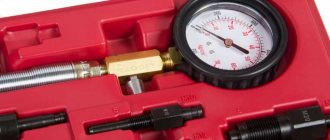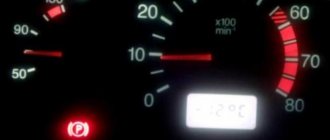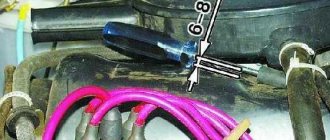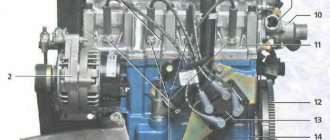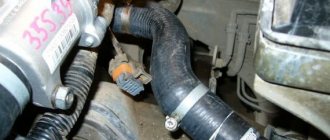Lost thrust from Lada Kalina engine
quote: maybe the idle is overflowing?
quote: Originally posted by ilja316: petrol engines replaced
quote: Originally written KIA 18: ilja316 good afternoon namesake) First of all, for diagnostics.
Hello!) Yes, I changed both
quote: Originally posted by Vad10: Is the oil level normal?
Thank you! Yes, I also thought about the ignition module
quote: Originally posted by AlexLiss-ar:
100 pounds high-voltage transformer.
quote: Originally written by ilja316: Yesterday evening, when returning home, the car began to stall, at times the traction was lost at speeds above 2.5 thousand. This morning I drove for about 10 minutes and pulled normally, after that the traction suddenly disappeared, it doesn’t even pull itself on a flat surface, the check engine light doesn’t light up
quote: Originally posted by vovchiky: well, that means somewhere the wires have rubbed against the engine, look at the harness on the injectors
Shouldn't the check light come on?
quote: Originally posted by VAVAN faza:
do you have viburnum? In January the error would most likely have popped up.
then there was a seven injector.
If the high-voltage coil is broken, which is more likely, the error will most likely not appear.
quote: maybe the idle is overflowing?
quote: I suspect that the RTD, fuel pump, TPS and contacts
quote: 100 pounds high-voltage transformer
quote: Thank you! Yes, I also thought about the ignition module
quote: do you have viburnum? In January the error would most likely have popped up.
quote: well, that means somewhere the wires have rubbed against the engine, look at the harness on the injectors
quote: back then there was a seven injector. If the high-voltage coil is broken, which is more likely, the error will most likely not appear.
Not quite clear. Isn’t it easier to go somewhere to a trusted place, pay a ridiculous amount and forget, than to read, write nonsense and suffer with the car, while changing the floor of the car in vain?
quote: Originally posted by vic-18: Didn’t you find it yourself?
I stopped by the nearest service center in the morning and asked to measure the pressure in the fuel rail. We moved on from this
quote: Originally posted by vic-18: I won’t believe it in my life!
quote: Originally posted by vic-18: And even the new high-voltage transformer was not useful?
quote: Originally posted by vic-18:
Didn't you find it yourself? I won’t believe it in real life! And even the new high-voltage transformer was not useful? and didn’t overfill the idle?
quote: Originally posted by AlexLiss-ar:
100 pounds high voltage transformer
quote: Originally written vic-18: “high voltage coil”
quote: well, why troll? the person found the reason, figured it out himself, but the fact that he calls things by other names, the understanding of these things does not change, because, I think when they wrote
Source
More about engine problems
Is the engine acting up? Check the spark plugs!
So, what should we do if we set off on a long journey, but suddenly, unable to withstand a severe test of strength, the car stalled midway? The situation is not pleasant. But don’t give up, it’s time to get down to business. The problem may lie in the following.
- Most likely, you filled your car with gasoline of not the best quality. It's possible that debris somehow got into the motor. Just in case, it’s still worth cleaning the fuel lines and the tank itself, drying it and filling it with normal fuel that you are sure of. By measuring the pressure in the fuel rail, you will know whether there is a problem here or whether you need to look further.
- Damage to the fuel pump. It is easier to identify this problem: if the ignition is still turned on, then if there is a defect, the fuel pump makes a characteristic sound, indicating a malfunction. Remove the pump from the gas tank and check the outlet pressure in the tank using the power supply method. The pressure coefficient should not be less than 2 atmospheres.
- Ignition system failure: spark plugs do not produce a spark. To fix the breakdown, you just need to replace the spark plugs with new ones; it won’t take much time.
- Throttle assembly defective. This unit is the most important part that performs a significant part of the engine’s work. When it deteriorates, air and fuel mix, which leads to engine stupor.
- Injector failure. This is the most rarely encountered problem.
- It is necessary to adjust the timing valves if for some reason there is a violation of the clearances.
- The gas pedal needs repair.
- The motor has not yet been run in, so it malfunctions. The solution to the problem is simple: you need to be patient and break it in, driving 6000-7000 km. But it is worth remembering that the speed cannot be raised above 3000, otherwise serious repairs will be required after break-in.
This sensor monitors oil pressure
A fairly common cause of engine failure is insufficient oil pressure. How can you prevent this problem?
- It is worth knowing that low-quality oil that does not match the label will do more harm than good. This is reason #1.
- It is necessary to check the oil filter and pump for defects from time to time, and also replace the old lubricant with a new one. A blockage or leak leads to irreversible consequences.
- It is necessary to monitor the condition of the crankcase.
- Don't forget to inspect the oil passages. If there are missing plugs somewhere, put them in.
New Lada: Photo of Lada Granta FL (updated sedan, hatchback, station wagon and liftback)
Most Kalina drivers experience engine overheating. What needs to be done to prevent overheating? It is important to constantly monitor the coolant level. If suddenly the level drops to the minimum level, restore it.
Check from time to time to see if the radiator is getting hot. Check the condition of the electric fan. The test can be done by connecting it to the battery. Again, due to poor, low-quality fuel, overloads occur and, as a result, overheating.
The condition of the pump should be checked. The slightest defect will lead to breakage of the blades, which will start a chain reaction: the normal flow of coolant will stop, and then the power unit will fail.
The main reasons for the reduction in engine power
Crankshaft position sensor malfunction
There are situations when the DCPV untimely sends a control command to supply the air-fuel mixture. As a result, the power of the power unit drops before our eyes. The main cause of the failure is the shift of the toothed star relative to the pulley and the delamination of the damper. In such a situation, it is necessary to carefully inspect the damper and replace it.
Increasing (decreasing) the gap between the spark plug electrodes
During operation, due to strong temperature effects, the distance between the electrodes of the spark plug may decrease or increase. To exclude or confirm your suspicion, you need to check the size of the gaps using a round feeler gauge. If the distance is less or more than acceptable, you need to make an adjustment by bending the side of the electrode or replace the spark plug. As for the optimal spark gap distance, it can be different (depending on the type of spark plug) - 0.7-1.0 mm.
The appearance of carbon deposits on the spark plugs is another clear sign of a problem.
If the engine does not pull well, you need to unscrew all the spark plugs one by one and inspect them. If obvious carbon deposits appear on the electrodes, the device must be cleaned using a brush with metal bristles. It is important not only to clean the spark plugs or replace them, but also to find out the cause of this phenomenon.
Failure of spark plugs
A decrease in engine power may be caused by product failure. In this case, it is necessary to check the performance of the spark plug on a special stand. If the suspicions are confirmed, then the only way out is to replace the set or one spark plug.
There is no gasoline in the tank
You can diagnose the problem using the fuel level indicator. If it is faulty or there is a suspicion that it is “inadequate,” then the presence of fuel can be determined by removing the fuel pump.
Fuel filter contamination, water freezing in the system, pinched fuel wire, fuel pump failure
All these malfunctions can be safely classified into one category, because they all have the same symptoms - the starter cranks the engine, but there is no smell of fuel from the exhaust pipe. If the car has a carburetor, then the reason must be sought in the float chamber. Most likely, fuel is not supplied to it. In the case of an injector, it is easier to check the presence of fuel in the ramp by pressing a special spool (installed at the end of the ramp).
To correct the problem, you need to warm up the engine thoroughly and bleed the power system with a tire pump. After this, all system pipes, hoses and the fuel pump itself are changed.
Dips when pressing the gas pedal Lada Kalina: acceleration and idling
What is "failure"? This is an effect in which the car does not accelerate when you press the gas pedal. Usually the failure lasts a few seconds, and then the “jerk” effect occurs. This is a fairly common malfunction associated with the fuel injection system. On Kalina, it does not occur often, but it does happen.
Video about gas failures on an injection engine:
This video material will talk about such a malfunction as gas leaks, the causes of occurrence, methods of elimination, and also contains some recommendations for car owners.
Causes of the phenomenon
Drop in speed and failure of the gas pedal
There are few reasons for the phenomenon of “failure” when pressing the gas pedal. It often appears after unsuccessful engine chip tuning and is accompanied by an increase in fuel consumption, but there are other problems directly with injection. So, let’s look at the main reasons for the “failure” effect:
- Injectors. The fuel distribution system directly affects engine performance.
- Damage to the injector.
- The fuel supply system has failed.
- Wear of engine temperature and mixture enrichment sensors.
- Errors in the electronic engine control unit.
Identifying and eliminating ECU errors
Spark plug. This is the most common cause of accelerator pedal failure.
Condition of the candles. On the left the mixture is too rich, on the right it is too lean.
These are all the main reasons that can lead to gas pedal failure.
Dips during acceleration
Once the causes are considered, we can consider how to deal with the problem. So, let’s describe step by step what needs to be done when the gas pedal has dips during acceleration:
- The first step is to check the spark plugs. The appearance of carbon deposits or spark plugs that are too clean indicate that the mixture is not adjusted correctly. It is worth adjusting the correct amount of fuel mixture.
- Ignition wires can also cause the vehicle to malfunction.
- A clogged throttle can lead to failures during acceleration.
- The condition of the air filter affects the formation of the mixture, so it is worth changing it on time.
Air filter clogged
The fuel pump (main faults), as well as the condition of the fuel filter, can affect injection. Therefore, in case of failures, it is necessary to diagnose them. To diagnose, you need to remove the fuel pump and check its operation, as well as the condition of the mesh filter.
Dirty fuel filter
Dirty fuel filter
Thus, the causes of failures during overclocking have been identified and can be eliminated.
Gas leaks at idle
At idle, there are fewer reasons for failures, but they will have to be eliminated, since the car simply will not start normally, or stall after starting the engine. So, let's look at the work plan step by step:
- Checking the spark plugs. If the element fails, it is necessary to replace it.
Attention! It is recommended to change all four spark plugs to ensure smooth engine operation. Before installation, you should adjust the gap using a feeler gauge, which should be 1 mm for 92 gasoline.
Checking and adjusting the spark plug gap using a feeler gauge
- We change the fuel filter, it is located under the bottom of the tank, and also carry out diagnostics on the fuel pump. If malfunctions are identified, they should be eliminated.
Clogged filter in the gasoline pump
All these reasons can cause dips to appear at idle (more precisely, when switching from idle to driving mode).
conclusions
The main cause of failures are spark plugs, but they are not the only ones that influence the appearance of this effect. Some car enthusiasts may not be able to cope with the occurrence of such malfunctions on their own, and it is necessary to go to a car service center, where they will carry out high-quality diagnostics and also fix the problem. But it is worth considering that you will have to be generous, since neither computer diagnostics nor repairs will cost a penny.
How to repair the idle speed control
In fact, the injector does not need to be adjusted, because the intelligent on-board control system is responsible for the operation of the machine. The idle speed regulator, built into the injector, is a mechanism that opens and closes the air flow again, and the air itself passes through a channel specially equipped for this. Unfortunately, it is difficult to determine the exact breakdown of the idle air control (IAC) based on the readings on the on-board panel - the fault signal will not light up. But what will immediately become apparent is the instability of the rotations or their complete disappearance. If there is a “Check” signal on the instrument panel of the VAZ-2107, it is quite possible that the IAC is to blame. This means that the engine is detonating, and this signal is transmitted to the control unit, which is powered by electronics.
The Lada Kalina car engine stalls when idling
One of the components that causes the Kalina engine to stop idling is the idle speed regulator (IAC), which becomes clogged with sticky dirt. As a result, its needle remains in the closed position, and the combustible mixture stops flowing into the engine cylinders.
In order to remove the IAC from its installation site and clean the needle using a special solvent or at least alcohol (liquid should not get inside), you must first warm up the engine, then disconnect the wires from it and immediately turn off the engine. In this case, the IAC needle (after removing it) will stick out above the plane of the connector and will be easier to clean. In this way, you can reanimate the IAC, but if this does not help, then it will have to be replaced. There are cases when voltage is simply not supplied to the IAC; in this case, you will have to check the contacts in the plug connectors and the integrity of the wires going to it.
The second problem with the engine idling may be the throttle sensor, which fails due to fairly rapid wear of the resistive layer of the variable resistor, since this layer does not like moisture and dust.
Source: helping-auto.ru
Analysis of the causes of poor engine traction and possible repairs
Fuel filter dirty
This may be due to low-quality gasoline (containing various small debris) or infrequent cleaning of the fuel tank. In this case, you will have to completely replace the entire filter system.
Fuel pump diaphragm clogged
The cause of the blockage, as a rule, is low-quality gasoline. To clean it, just remove the diaphragm and rinse it thoroughly or blow it with air.
Malfunction of the sensor that controls air flow
This is the most common reason why the VAZ 2114 does not work.
It is worth periodically checking the operating condition of the air flow meter to avoid wasting time and money diagnosing the engine.
Air filter dust
The more the filter is clogged with dust, the less air flows to the engine, therefore, the thrust decreases. What can be done in this case? Ideally, the filter should be replaced with a new one, but if this is not possible, you should remove the filter, tap and blow to remove large debris (flies, dry leaves, insects).
How to repair an injector in a VAZ-2107
If replacing the sensors does not produce results, it is better to go to a service station. The banal lack of tightness of the intake manifold provokes the same problem when the car stalls at idle. With your own hands, inspect the vacuum hoses, gaskets, injector sealing rings, and then the plugs that are located in the manifold, and the vacuum brake pedal booster. It is easy to detect air leaks using a special unit called a smoke generator. Do not ignore checking the gasoline pressure.
If a pressure regulator is installed on the VAZ-2107 ramp, the optimal value fluctuates around 2.5 bar, but this is only at idle without a vacuum device. With a vacuum device, a value of 3.8 to 4 bar is permissible. Spark plugs must also be checked.
How to clean the VAZ-2107 injector nozzle is shown in the video:
If the engine does not pull (loss of power, dips or jerks)
| What to do if the dynamics of the car have decreased significantly, and it is no longer possible to overtake the car so quickly? There can be many reasons for this engine problem, and the main ones are listed in this table. |
| Possible cause of malfunction | Checking (diagnosis) of a malfunction | Troubleshooting methods |
| The control impulse from the DPKV arrives at the wrong time due to delamination of the crankshaft damper (the gear has moved relative to the pulley) | Visual inspection of the damper. | Replace damper. |
| The gap between the spark plug electrodes is not normal | Check the gaps with a feeler gauge. | Set the required gap by bending the side electrode, or replace the spark plugs (see which spark plugs to choose). |
| Heavy carbon deposits on spark plugs | Visual inspection. | Clean the spark plugs. Identify and eliminate the cause of soot formation. If necessary, replace the spark plugs (see which spark plugs to choose). |
| Non-functional spark plugs. | Candles are checked on a special stand. | Replace the spark plugs (see which spark plugs to choose). |
| There is no gasoline in the fuel tank | The fuel level indicator shows an empty tank. Determine the presence of gasoline by removing the fuel pump. | Pour gasoline into the tank. |
| The fuel filter is clogged, the water in the engine power system is frozen, the fuel line is pinched, or the fuel pump is faulty | The starter cranks the crankshaft, but there is no smell of gasoline coming from the exhaust pipe. (Carburetor) There is no gasoline in the float chamber of the carburetor - when you press the gas pedal there is no jet of fuel from the accelerator pump nozzle. (Injector) The presence of gasoline (under pressure) in the fuel rail can be checked by briefly pressing the spool of the fitting at the end of the rail (see about pressure in the fuel system). | Warm up the car and blow out the power system (with a tire pump). Replace the fuel pump, hoses and tubes. |
| The fuel pump does not create the required pressure in the fuel system | Check the pressure at the outlet of the fuel pump (see about pressure in the fuel system). Check the fuel pump filter. | Clean the fuel pump filter. Replace the fuel filter (see which filter to choose) and the fuel pump, which does not provide the required pressure. |
| Poor contact in the fuel pump power circuit or its relay is faulty | Checked with an ohmmeter. Check the "mass". | Clean the contacts, crimp the terminals, replace the relay (see mounting block) and wires. |
| Faulty injectors or their circuits | Check the injector windings and their circuits with an ohmmeter for open circuits and short circuits. The ECU is diagnosed at a service station. | Replace the faulty ECU (see ECU interchangeability). Clean the injectors or replace them with new ones (see which injectors to choose). Ensure contact in electrical circuits. |
| Inoperative crankshaft position sensor (CPS) or its circuit | The “Check engine” lamp is on. Check the DPKV circuit, the absence of damage to the sensor itself and the gap between it and the crankshaft damper ring gear (1±0.2 mm). Sensor resistance is 500–700 Ohms. | Restore contact in electrical circuits, replace the faulty sensor. |
| Inoperative coolant temperature sensor (DTOZH). | The “Check engine” lamp is on. If there is a break in the DTOZH or its circuit, the electric fan of the cooling system runs continuously. Check the DTOZH. | Restore contact in the electrical circuits, replace the faulty sensor. |
| The throttle position sensor (TPS) or its circuit is faulty | The “Check engine” lamp is on. If there is a break in the circuit or sensor, the engine speed does not drop below 1500. | Clean the throttle assembly, restore contact in the electrical circuits, replace the faulty sensor. |
| Inoperative mass air flow sensor (MAF) | Check the mass air flow sensor, or replace the sensor with a known good one. | Clean the mass air flow sensor, replace if necessary (see which mass air flow sensor to choose). |
| Inoperative knock sensor | If the wire is broken, the “Check engine” lamp lights up. There is no detonation in any mode. Loss of engine power. | Restore contact in electrical circuits, replace the faulty sensor. |
| Inoperative oxygen sensor or circuit | "Check engine" light is on. The integrity of the heating coil is checked with an ohmmeter, the output voltage is checked with a voltmeter (the voltmeter should be connected without breaking the circuit, for example, by piercing the wires with thin needles). | Repair the oxygen sensor. Restore the wiring, clean the air leak hole. Replace the oxygen sensor. |
| Leakage of the exhaust system (area up to the oxygen sensor) | Visual inspection at medium engine speed. | Replace the exhaust manifold gasket, tighten the seals (see replacing the exhaust manifold). |
| The engine control unit (ECU) and its circuits are faulty | Check the 12V voltage at the ECU. Replace the unit with a known good one. | Replace the ECU (see ECU interchangeability), wiring. |
| Inoperative fuel pressure regulator (FPR) | Check the pressure in the fuel rail. | Replace the regulator (see which regulator to choose). |
| The clearances in the valve drive are not adjusted (8-valve engines) | Check with a set of feeler gauges. | Adjust valve clearances. |
| Loose or broken valve springs (8-valve engines) | Inspection, measurement of the length of springs in a free state and under load. | Replace weak or broken springs. |
| Wear of camshaft cams/shafts | Visual inspection. | Replace camshaft. |
| The valve timing is off | Check the alignment of the marks on the crankshaft and camshaft. | Establish the correct relative position of the shafts (according to the marks). |
| Low compression in the cylinders (wear or damage to valves, seats, wear, sticking or breakage of piston rings) | Check compression in cylinders. | Replace rings and pistons. Cylinder repair. |
| (Carburetor) Engine is not warmed up | According to the temperature indicator | Warm up the engine at medium speed to operating temperature. |
| (Carburetor) Insufficient fuel level in the carburetor float chamber | — | Adjust the fuel level. |
| (Carburetor) The carburetor trigger or drive is faulty or not adjusted. | — | Adjust the starter or replace it. |
| (Carburetor) Excessive fuel level in carburetor float chamber | There is a strong smell of gasoline from the exhaust pipe; a cold engine starts better than a hot one. Remove the top cover of the carburetor and check the integrity of the floats, their ease of movement and the absence of touching the walls of the float chamber. To check the tightness of the needle valve, turn the carburetor cover with the floats up and pump up gasoline using the fuel pump lever. Gasoline leakage from under the needle or valve base is unacceptable. | Replace the needle valve. Adjust the fuel level in the float chamber. |
| (Carburetor) Over-rich mixture due to gasoline leaking into the engine crankcase through a torn fuel pump diaphragm | The oil on the dipstick smells like gasoline. The low oil pressure light comes on at idle speed. | Replace the fuel pump or diaphragm. Change the oil if it contains a lot of gasoline. |
| (Carburetor) The carburetor jets and passages are clogged. The jets and solenoid valve are not tightly wrapped | Inspect and blow out the channels and jets. | Wash with gasoline or acetone and blow out the jets. If they are heavily soiled, clean them with a fishing line or a soft wood needle. |
| Incomplete opening of the throttle valve/flaps | Inspection with the engine stopped. | Adjust the throttle valve drive. |
| (Carburetor) Accelerator pump or nozzle not working, carburetor fuel passages clogged | Check the pump supply and make sure there is no leakage of gasoline from under the diaphragm. Make sure that the accelerator pump lever moves freely. | Replace damaged parts, tighten threaded connections, and blow out valves. |
| (Carburetor) Incorrect ignition timing | — | Adjust the ignition timing. |
| (Carburetor) Wear, damage to the contact carbon in the ignition distributor cap. The coal spring has weakened | Visual inspection. | Replace the distributor cap or the angle with the spring. |
| (Carburetor) The resistor in the ignition distributor rotor has burned out | Checked with an ohmmeter (1 kOhm). | Replace resistor or rotor. |
| (Carburetor) Commutator faulty | Testing is carried out by installing a known-good switch. | Replace the switch. |
| (Carburetor) Weakening or breakage of the springs of the weights of the centrifugal automatic ignition distributor, the damper rings of the weights are lost, the weights are stuck | Visually and at a special stand. | Replace the ignition distributor. |
| (Carburetor) Fuzzy operation of the vacuum ignition timing regulator; when the vacuum is removed, the plate does not return to its original position, there is large play in the bearing | Determined by visual inspection. The characteristics of the vacuum regulator are measured on a special stand. | Eliminate the jam, replace the faulty vacuum regulator or ignition distributor. |
| (Carburetor) The fuel pump does not create the required pressure in the system | — | Replace the fuel pump or its diaphragms. |
Lada Kalina. The engine does not develop full power
The car does not have sufficient throttle response. Jerks and dips when moving
| Blow or replace the air filter element | ||
| Increased resistance to gas movement in the exhaust system | Inspect the exhaust system for dented and damaged pipes, check the condition of the catalytic converter (back pressure) (service station) | Replace damaged exhaust system components |
| Suction of foreign air into the intake tract | Inspect the joints, check the fit of the throttle assembly, absolute pressure and air temperature sensors. Briefly disconnect the brake booster by plugging the intake manifold | Replace gaskets, O-rings, parts with deformed flanges, faulty vacuum booster |
| Incomplete throttle opening | Determined visually with the engine stopped | Adjust the throttle valve actuator |
| Low compression in the engine cylinders (less than 11.0 bar): wear or damage to valves, their guides and seats, stuck or broken piston rings | Check compression | Replace faulty parts |
| Disturbed valve timing | Check valve timing | Establish the correct relative position of the shafts. Check compression |
| The gaps between the electrodes of the spark plugs do not correspond to the norm | Check clearances | By bending the side electrode, set the required gap or replace the spark plugs |
| Heavy carbon deposits on the spark plug electrodes; ingress of carbon particles into the gap between the electrodes | Inspection | Check and replace spark plugs if necessary |
| Damage to the insulation of high-voltage devices and circuits | Using an ohmmeter, check for open or breakdown (short to ground) of the ignition coil windings and high-voltage wires | Replace damaged ignition coil, high-voltage wires |
| There is not enough fuel in the tank | By level indicator and fuel reserve indicator | Add fuel |
| The fuel filter is clogged, the water that has entered the power system is frozen, the fuel pipes are deformed | Check fuel system pressure | Replace the fuel filter. In winter, place the car in a warm garage and blow out the fuel lines. Replace defective hoses and tubes |
| The fuel pump does not create the required pressure in the system | Check the pressure in the fuel system, make sure the fuel module strainer is clean | Clean the fuel module strainer. Faulty fuel pump, pressure regulator, replace |
| Poor contact in the fuel pump power supply circuit (including ground wires) | Checked with an ohmmeter | Clean contacts, crimp wire ends, replace faulty wires |
| Faulty injectors or their circuits | Check the injector windings and their circuits with an ohmmeter (no open or short circuit) | Replace faulty injectors, ensure contact in electrical circuits |
| The air temperature sensor or its circuits are faulty | Check the sensor and its circuits | Restore contact in electrical circuits, replace the faulty sensor |
| The absolute air pressure sensor or its circuit is faulty | You can evaluate the performance of the absolute air pressure sensor using diagnostic equipment at a service station | Restore contact in electrical circuits, replace the faulty sensor |
| The oxygen concentration sensor is faulty | You can evaluate the performance of the oxygen concentration sensor and the reliability of its electrical circuit connections using diagnostic equipment at a service station | Restore damaged electrical circuits. Replace faulty sensor |
| The ECU or its circuits are faulty | To check the ECU, replace it with a known good one. | Replace the faulty ECU |
| The clearances in the valve drive are not adjusted | Check valve clearances | Adjust the clearances in the valve drive |
| Severe wear on the camshaft cams | Inspection during engine disassembly at a service station | Replace the worn camshaft at a service station |
| Loose or broken valve springs | Inspection during engine disassembly | Have the engine repaired at a service station |
| The throttle position sensor or its circuit is faulty | Check the throttle position sensor | Restore contact in electrical circuits, replace the faulty sensor |
| Coolant temperature sensor faulty | Check the sensor resistance at different temperatures with a tester | Restore contact in electrical circuits, replace the faulty sensor |
The engine does not develop full power
You need to pay attention to the loss of engine power when it goes beyond the 15 percent mark and if the car (in good condition) accelerates with difficulty on a flat, dry and hard road. There are plenty of reasons for this phenomenon, since in a machine, as in a living organism, everything is interconnected. The most common causes of power loss in a power unit
Early ignition
One of the elementary reasons for a decrease in engine power can be early ignition. In this case, the force of the exhaust gases goes against the movement of the piston due to the fact that the fuel mixture ignites prematurely. As a result, the engine cannot develop its full power. Delayed ignition also negatively affects vehicle speed. Here, on the contrary, the fuel mixture does not have time to burn until the moment when the piston reaches the dead center and the resulting energy is far from being fully used. The third reason may lie in a malfunction of the vacuum ignition timing regulator. Engine speed directly depends on how well the carburetor throttle valves are open. If the regulator diaphragm is damaged, it begins to function with great difficulty or fails altogether, which, in fact, immediately affects the power of the power unit
Also, the centrifugal ignition timing regulator may be to blame for the reduction in engine power, a malfunction of which leads to the problem described. As the engine speed increases, the centrifugal regulator begins to increase the ignition timing, but if its weights jam, the angle does not change throughout the entire operation of the engine and it loses its power. In this case, excessive fuel consumption is often observed due to early ignition, which occurs due to the rapid stretching of the weight springs. It is impossible to imagine the normal operation of the engine, and, accordingly, the combustion chambers, without the valves being tightly seated in the seats intended for them. Depending on the type of engine, the gap between the pusher shim and the end of the rod must be of a certain size. If the gap is increased, the tightness of the combustion chamber is compromised, which significantly reduces engine power. And with a reduced clearance, the valve edges and seats usually burn out. You can determine a loose fit by the shots: if a shot goes into the carburetor, this means that the intake valve does not fit tightly, and if a shot goes into the muffler, it means that the exhaust valve is not tight enough. Last but not least on the list is the cause of worn piston rings. In this situation, compression in the cylinders decreases, which immediately affects engine power. It is quite easy to determine whether rings are worn out. To do this, you need to remove the crankcase ventilation hose from the breather and if smoke comes out from there, it means the rings are worn out. The smoke resembles a dark stream with a pulse.
Insufficient filling of the cylinders with the working mixture
But what could be the reason for the decrease in engine power when the ignition is adjusted and the ignition timing regulators are working properly? In this case, you should check that the cylinders are full of the working mixture. Most often, this problem occurs due to the throttle valve sticking, so you sometimes need to pay attention to its drive. After this, you need to check the serviceability of the air filter, which, if necessary, is quickly removed and a new one is installed in its place. As practice has shown, a lack of working mixture in the cylinders can occur for four reasons: excessive carbon deposits in the engine cylinders; large deposits of coke and tar in the inlet pipe; sticking in the needle valve float chamber; using fuel with an octane number that does not match the number prescribed by the instructors.
Poor working mixture
The entry of a lean working mixture into the cylinders is also one of the reasons for the reduction in engine power. There are a number of reasons for the formation of a lean mixture, which can be eliminated fairly quickly: Air leaks at the junction of carburetor elements due to damage to the gaskets or due to loose fastenings. Transmission can be detected using soap suds. Where suction occurs, a void (window) is usually formed. Air leakage is removed by tightening the bolts and replacing sealing gaskets where required. Other reasons may be freezing of the liquid in the power system, contamination of the channels and jets in the carburetor, or contamination of the fuel lines. The situation can be corrected by blowing out the jets, fuel lines and channels using an ordinary pump used to inflate tires. If blowing does not give the proper result, then the carburetor must be disassembled and cleaned with copper wire. Clogging of the fuel pump air hole, wear of its drive lever and sticking of the air damper are the reasons for the formation of a lean mixture for the cylinders. These malfunctions are eliminated by replacing all non-working components of the fuel pump with new ones, cleaning the plug hole, and adjusting, if necessary, the length of the cable that controls the air damper. A small diaphragm breakthrough, sticking of the fuel pump valves and contamination of the strainer help create a working mixture. Problems are removed by washing the filter, restoring or replacing the diaphragm and eliminating stuck valves. It is worth knowing that sometimes a decrease in engine power occurs due to the influence of weather conditions. So, for example, in winter this problem occurs due to icing of the carburetor, and in summer the car loses speed due to a vapor lock or worn-out fuel pump. It turns out that the car owner can fix half of the problems on his own, but if there is no confidence in the correctness of his actions, then it is better to entrust this work to real professionals working at the service station.
Other reasons
Why doesn't the engine develop full power?
Lean mixture entering the cylinders. Filling the cylinders with a lean mixture always leads to a significant reduction in engine power. In this case, the car moves at reduced speeds; it takes more time to accelerate on a dry road with a hard and smooth surface when the vehicle’s chassis mechanisms are in good technical condition.
The reasons for the formation of a lean mixture are the following: clogged jets and channels in the carburetor, contamination of fuel lines, freezing of water in the power system. In this case, it is necessary to blow out the jets, channels and contaminated fuel lines using a tire inflation pump, and if necessary, clean them with copper wire by disassembling the carburetor;
stuck fuel pump valves, clogged strainer or ruptured diaphragm. In this case, first remove the stuck fuel pump valves, wash the strainer, and replace the broken diaphragm or temporarily restore it in the manner described earlier;
air leakage at the junction of carburetor parts, carburetor flange with exhaust pipe, intake pipe flanges with cylinder block due to loose fastenings, as well as damage to gaskets. The location of the leak can be detected using soap suds. A window will form in the soap suds at the expected location of the leak. Air leaks are eliminated by tightening nuts or bolts, as well as replacing the corresponding sealing gaskets;
wear of the fuel pump drive lever, clogging of the air hole connecting the fuel tank to the atmosphere, jamming of the air damper. These malfunctions are eliminated as follows: replace faulty parts of the fuel pump, clean the air hole of the plug, check and, if necessary, adjust the length of the carburetor choke control cable.
Late ignition. If the engine does not develop full power, then it is best to check the ignition installation. If the ignition is too late, the engine loses throttle response. A significant reduction in power occurs because the mixture does not have time to burn at the moment when the piston is at TDC. Combustion of the mixture continues as the piston moves downwards. This is evidenced by increased heating of the exhaust pipeline. It will be too hot because some of the mixture will burn when released.
Early ignition. A decrease in engine power also occurs when ignition is too early, when the combustible mixture ignites prematurely and the force of the gases acts against the piston, which moves towards TDC. At the same time, frequent and loud metallic knocks are heard in the engine, detonation may occur, the engine does not work well at low crankshaft speeds, and when started with the crank, it sometimes gives back knocks.
If by adjusting the ignition timing using the methods discussed earlier, it is not possible to achieve the desired results, then, obviously, malfunctions have arisen in the devices for automatically adjusting the ignition timing - centrifugal or vacuum regulators.
The vacuum ignition timing regulator is faulty. On the way, the car has to move both on a flat road and on a road with inclines. Let's assume that when driving at a constant speed both on a flat road and on an uphill road, the centrifugal regulator will only provide the same ignition timing. But when driving on a hilly road, the engine load and throttle opening are much greater, so the ignition timing must be less than when driving on a flat road at the same speed.
Violation of clearances in the valve mechanism. It is known that a tight fit of the valve in the seat, i.e. its complete closure, is ensured due to the thermal gap in the valve mechanism. If the normal values of thermal clearances established by the requirements of the factory operating instructions for vehicles are violated, the engine loses power. With small gaps, valves and their seats burn out. The presence of large gaps in the valve mechanism causes not only a loss of engine power, but also a characteristic metallic knocking sound of the valves. In addition, loose closure of, for example, an exhaust valve due to abnormal clearances is characterized by “shots” in the muffler, and a loose fit of the intake valve is characterized by “sneezing” in the carburetor.
Both small and large clearances in the valve mechanism negatively affect not only the efficiency of the engine, but also the service life of its parts. Abnormal clearances in the valve mechanism are adjusted in the manner discussed earlier.
Wear of piston rings. Piston rings provide a tight seal between the piston and cylinder, preventing gases from escaping into the engine crankcase, and also prevent oil from penetrating into the combustion chamber.
When the piston rings wear out (burning of the rings in the piston grooves, loss of their elasticity), compression in the cylinders sharply decreases, which leads to loss of engine power, increased oil and gasoline consumption; Black smoke comes out of the muffler.
Compression in the engine cylinders is checked using a compression gauge and manually.
Contamination of the muffler. During the operation of the car, due to the engine running on a too rich mixture, incomplete combustion occurs. Unburnt fuel is thrown out in the form of soot, and part of it settles on the inner wall of the muffler, gradually contaminating it. In addition, contamination of the muffler is also possible when the vehicle is carelessly reversing on a bumpy dirt road. If the muffler is dirty, the engine loses power. The condition of the muffler can be determined by external inspection and a light blow from the outside. A clean muffler produces a high-pitched metallic sound, while a dirty muffler produces a dull sound.
A dirty muffler must be cleaned, as this leads not only to loss of engine power, but also to excessive consumption of gasoline, as well as premature wear of the muffler.
content .. 12 13 14 15 ..
Stuttering when accelerating? Dig! — logbook Lada Kalina Sedan 2006 on DRIVE2
As you know, every car requires attention. So mine demanded it. Sluggish acceleration, vibration, consumption, shocks when switching. List of suspects:1. MAF sensor. I recently measured www.drive2.ru/l/477094589040165062/. The multimeter reading is 1.04 V.
According to the diagnostics, it showed 1.016 V. There is a third way - remove the chip from the mass air flow sensor and drive it. I haven't tried it.
2. Candles. I forgot to take a photo. Yesterday I took it off, like new. Candles cost 17 dv. www.drive2.ru/l/473344429755728085/. I'm going to install DENSO.
3. Air filter. Yesterday I took it out dirty. I blew it out from the compressor. I was breathing better. It was easier to go.
photo from the Internet. It looks like it was for me.
4. I have long wanted to try running antifreeze past the throttle valve. The fitting was used from an old radiator.
5. Corrugation. www.drive2.ru/l/478326591819088066/. I've seen some cars come out inside. I thought so too. It turned out not. It just rattled and siphoned. Although sound could also play a role. After replacement the vibration went away.
6. It remains to look at the injectors. There is no smell of gasoline. But the O-rings have already been purchased. I took washing for the injector and valves. I'll do it as soon as I fill the tank full. After this, you will need to replace the spark plugs as recommended.
Why doesn't the car pull and what needs to be checked in this case?
If the car does not show its former power and traction, you will not get any pleasure from driving. Moreover, the consumption of gasoline or diesel fuel often increases, and the risk of failure of any units increases. The car owner intuitively understands that something is wrong in the design of the vehicle. Therefore, there is a desire to check the car, find the cause of the defect and get specific solutions to the problem. Today we will talk about why the car does not pull, and also what needs to be done in such situations, where you should look first. If you encounter such a problem suddenly, it is worth quickly diagnosing the main components of the machine, identifying the problem and eliminating the cause of the loss of power. If the problem has been present for a long time, it’s time to go to a service station and solve this issue.
If you drive for a long time with most of the problems that cause loss of traction, you can completely ruin the power unit and end up needing expensive repairs. So we strongly recommend that you immediately pay attention to a noticeable loss of engine power or a real feeling that someone is holding you by the exhaust pipe and is not allowing you to accelerate. The longer you think it will go away over time, the more damage you can do to your car. This will also cause excessively expensive repairs in the long run. Let's consider the main reasons for this phenomenon.
Stop driving with the handbrake, and traction will appear by itself
If you always set your car's handbrake but forget to release it while driving, prepare for compromised traction. When driving with the handbrake, you get the feeling that the car accelerates very slowly and it is too difficult to gain momentum. The driver immediately puts pressure on the engine, putting pressure on the suspension or gearbox. But he can’t even think that it’s enough to lower the handbrake lever for the problem to solve itself. Moreover, driving with the handbrake for quite a long time will cause the following troubles with the car:
Source
Problems with the engine (troits, jerks, pulls poorly), causes
05 October 2015 LadaOnline 65 831
Does the car jerk at low speeds or when accelerating? Is the engine running rough and the Check Engine light on? Has the car lost its dynamics and doesn’t drive like before? In this article we will tell you about all the possible causes of these malfunctions and how to solve the problem.
It is worth noting that the causes of malfunctions are similar for all modern Lada cars (Kalina, Granta, Priora, Largus, Vesta, Niva or XRAY), because AvtoVAZ equips them with engines with identical characteristics.
It is recommended to start searching for a problem with diagnostics (reading errors). If this is not possible, then we first perform a test (or temporarily install a known working spare part/sensor), and only then replace the faulty parts.
If the engine idles or the car jerks when accelerating (driving), possible reasons:
Malfunctions in the ignition system
- The spark plugs are faulty.
- High voltage wires are faulty.
- Ignition module/coils are faulty.
Malfunctions in the fuel system
- The fuel filter or fuel line is clogged.
- The fuel injectors or their circuits are faulty.
- The fuel pump is faulty.
- The fuel pressure regulator (FPR) is not working.
You need to check the pressure in the fuel system.
Malfunctions of sensors or their circuits
- Crankshaft position sensor (CPS).
- Coolant temperature sensor (CTS).
- Throttle position sensor (TPS).
- Mass air flow sensor (MAF).
- Knock sensor (DS).
- Oxygen sensor (OS).
More details about sensors.
Other engine and system malfunctions
- Compression in the engine cylinders is low.
- The cylinder head gasket is damaged.
- The engine control system is faulty.
- The valves of the gas distribution mechanism are burnt out and leaky.
- The exhaust system is leaking.
- The valve clearances are not adjusted (8-valve engines only).
- The hydraulic pushers are faulty.
- The engine air filter is dirty.
- Vacuum hose connections are leaking.
Have you encountered power failures or observed unstable engine operation? What was the reason? We solve similar power unit problems in the comments or on the forum. Let us remind you that along with misfires, other engine malfunctions may appear, for example, floating speed.
Keywords: Lada Granta engine | Lada Priora engine | Lada Kalina engine | Lada Kalina 2 engine | Lada Largus engine | Lada Vesta engine | Niva engine | lada xray engine | universal article
0 0 Found an error? Select it and press Ctrl+Enter.. Related materials
- The speed fluctuates, the engine stalls at idle or when driving
- Which spark plugs are better to choose for Lada Largus
- Why the Lada Granta does not start, causes of malfunctions
- Injectors
. The fuel distribution system directly affects engine performance.Clogged injectors
- Damage to the injector
. - The fuel supply system
has failed . -
engine temperature and mixture enrichment sensors - Errors
in the electronic engine control unit.Identifying and eliminating ECU errors
- Spark plug
. This is the most common cause of accelerator pedal failure.Condition of the candles. On the left the mixture is too rich, on the right it is too lean.
xn--80aal0a.xn--80asehdb
“Peter - AT” INN 780703320484 OGRNIP 313784720500453
What is "failure"? This is an effect in which the car does not accelerate when you press the gas pedal. Usually the failure lasts a few seconds, and then the “jerk” effect occurs. This is a fairly common malfunction associated with the fuel injection system. On Kalina, it does not occur often, but it does happen.
Video about gas failures on an injection engine:
This video material will talk about such a malfunction as gas leaks, the causes of occurrence, methods of elimination, and also contains some recommendations for car owners.
Drop in speed and failure of the gas pedal
There are few reasons for the phenomenon of “failure” when pressing the gas pedal. Often it appears after unsuccessful engine chip tuning and is accompanied by, but there are other problems directly with injection. So, let’s look at the main reasons for the “failure” effect:
These are all the main reasons that can lead to gas pedal failure.
Dips during acceleration
Once the causes are considered, we can consider how to deal with the problem. So, let’s describe step by step what needs to be done when the gas pedal has dips during acceleration:
- The first step is to check the spark plugs. The appearance of carbon deposits or spark plugs that are too clean indicate that the mixture is not adjusted correctly. It is worth adjusting the correct amount of fuel mixture.
- Ignition wires can also cause the vehicle to malfunction.
- A clogged throttle can lead to failures during acceleration.
- The condition of the air filter affects the formation of the mixture, so it is worth changing it on time.
Air filter clogged - The fuel pump (), as well as the condition of the fuel filter, can affect injection.
Therefore, in case of failures, it is necessary to diagnose them. To diagnose and check its operation, as well as the condition of the mesh filter. Dirty fuel filter - ECU errors can also lead to accelerator failures.
- The last reason is clogged injectors. They need to carry out diagnostics, check functionality, and also clean and replace faulty elements.
Thus, the causes of failures during overclocking have been identified and can be eliminated.
Gas leaks at idle
At idle, there are fewer reasons for failures, but they will have to be eliminated, since the car simply will not start normally, or stall after starting the engine. So, let's look at the work plan step by step:
- Checking the spark plugs. If the element fails, it is necessary to replace it.
Checking and adjusting the spark plug gap using a feeler gauge
All these reasons can cause dips to appear at idle (more precisely, when switching from idle to driving mode).
